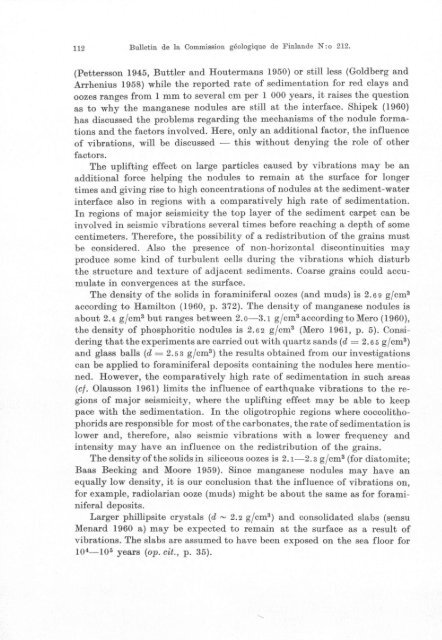COMMISSION GEOLOGIOUE - Arkisto.gsf.fi
COMMISSION GEOLOGIOUE - Arkisto.gsf.fi
COMMISSION GEOLOGIOUE - Arkisto.gsf.fi
Create successful ePaper yourself
Turn your PDF publications into a flip-book with our unique Google optimized e-Paper software.
112 Bulletin de 1a Commission geologique de Finlande N: 0 212.<br />
(Pettersson 1945, Buttler and Houtermans 1950) or stilliess (Goldberg and<br />
Arrhenius 1958) while the reported rate of sedimentation for red clays and<br />
oozes ranges from 1 mm to several cm per 1 000 years, it raises the question<br />
as to why the manganese nodules are still at the interface. Shipek (1960)<br />
has discussed the problems regarding the mechanisms of the nodule formations<br />
and the factors involved. Here, only an additional factor, the influence<br />
of vibrations, will be discussed - this without denying the role of other<br />
factors.<br />
The uplifting effect on large particles caused by vibrations may be an<br />
additional force helping the nodules to remain at the surface for longer<br />
times and giving rise to high concentrations of nodules at the sediment-water<br />
interface also in regions with a comparatively high rate of sedimentation.<br />
In regions of major seismicity the top layer of the sediment carpet can be<br />
involved in seismic vibrations several times before reaching a depth of some<br />
centimeters. Therefore, the possibility of aredistribution of the grains must<br />
be considered. Also the presence of non-horizontal discontinuities may<br />
produce so me kind of turbulent cells during the vibrations which disturb<br />
the structure and texture of adjacent sediments. Coarse grains could accumulate<br />
in convergences at the surface.<br />
The density of the solids in foraminiferal oozes (and muds) is 2.69 g/cm 3<br />
according to Hamilton (1960, p. 372). The density of manganese nodules is<br />
about 2.4 gjcm 3 but ranges between 2.0-3.1 gjcm 3 according to Mero (1960),<br />
the density of phosphoritic nodules is 2.62 gjcm 3 (Mero 1961, p. 5). Considering<br />
that the experiments are carried out with quartz sands (d = 2.65 gjcm 3 )<br />
and glass balls (d = 2.53 g/cm 3 ) the results obtained from our investigations<br />
can be applied to foraminiferal deposits containing the nodules here mentioned.<br />
However, the comparatively high rate of sedimentation in such areas<br />
(cf. Olausson 1961) limits the influence of earthquake vibrations to the regions<br />
of major seismicity, where the uplifting effect may be able to keep<br />
pace with the sedimentation. In the oligotrophie regions where coccolithophorids<br />
are responsible for most of the carbonates, the rate of sedimentation is<br />
lower and, therefore, also seismic vibrations with a lower frequency and<br />
intensity may have an influence on the redistribution of the grains.<br />
The density of the solids in siliceous oozes is 2.1-2.3 gjcm 3 (for diatomite;<br />
Baas Becking and Moore 1959). Since manganese nodules may have an<br />
equally low density, it is our conclusion that the influence of vibrations on,<br />
for example, radiolarian ooze (muds) might be ab out the same as for foraminiferal<br />
deposits.<br />
Larger phillipsite crystals (d ~ 2.2 gjcm 3 ) and consolidated slabs (sensu<br />
Menard 1960 a) may be expected to remain at the surface as a result of<br />
vibrations. The slabs are assumed to have been exposed on the sea floor for<br />
10 4 -10 5 years (op. eit., p . 35).
















